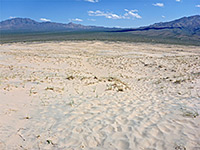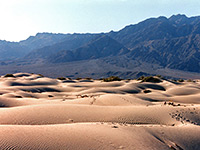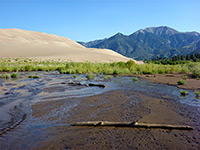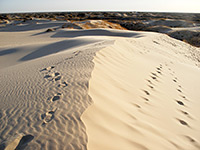Besides obvious locations along the Pacific coast, sand dunes cover large areas of the Southwest deserts and are also found in some higher elevation regions like the Colorado Plateau. It is rare for dunes to be completely unvegetated, as grass and bushes tend to encroach, but some of the most barren and extensive stretches of sand are part of state parks or NPS preserves, in which the scenery is at least one of the attractions, even though in some locations ATV use accounts for most visitors.
The largest continuous dunes in California are in the southeast, stretching over 40 miles between Niland and the Mexican border near Yuma - these are the Algodones Dunes, part of which is managed by the BLM as Imperial Sand Dunes Recreation Area, a major center for off-highway vehicles. Casual visitors may view the dunes either along Hwy 78 or from a rest area on I-8. Another desert dune system is the Kelso Dunes, in Mojave National Preserve, reached by a short side track off Kelbaker Road. This is an extensive patch of shapely, windblown dunes, composed of pinkish quartz and feldspar particles, surrounded by flat desert and distant mountains.
Further north, Death Valley National Park contains several noted dune fields, namely at Mesquite Flat near Stovepipe Wells (the most easily accessed location), Eureka Valley in the far north, Saline Valley in the northwest, Panamint Valley in the west (3 miles from CA 190) and near Saratoga Springs in the southeast corner (the Ibex Dunes).
Coastal dunes in California are protected in several parks including Fort Ord Dunes State Park near Marina, Tolowa Dunes State Park near Crescent City in the far north, Samoa Dunes Recreation Area near Eureka, and Oceano Dunes SVRA (formerly Pismo Beach). The last two are open for ORV use.
Perhaps the most unusual dune system in California is found in Lassen Volcanic National Park; the Painted Dunes are a group of undulating, red and black hills made of volcanic ash, viewable by a trail in the Cinder Cone region.
Colorado, New Mexico and (west) Texas each have one well-known dune-based park. The best, and one of the most magical places in the whole Southwest, is White Sands National Park in New Mexico - 275 acres of pure white gypsum dunes, almost completely lacking in vegetation, sat in a wide, flat valley beneath the San Andres mountains. In Colorado, Great Sand Dunes National Park and Preserve features the tallest dunes in America, up to 700 feet high, with a rather incongruous location at the edge of the Rocky Mountains at elevation 7,500 feet. In Texas, Monahan Sandhills State Park contains a smaller area of golden dunes, still quite impressive, beside I-20 west of Odessa. Camping and sand-based recreation are the attractions for most visitors. Another Texas dune field is along the Gulf Coast, where Padre Island National Seashore protects a barrier island 80 miles long.
In Utah, small areas of dunes are found in such parks as Capitol Reef, Monument Valley and Grand Staircase-Escalante. There are three state parks with sand dunes, all of which allow ORV use - Little Sahara near Jericho at the edge of the Great Basin Desert, Coral Pink Sand Dunes near Kanab and Sand Hollow near St George, a recently created park that also contains a reservoir and outcrops of weathered red rocks. All three have campgrounds, and Little Sahara is the most scenic place, best for hiking and photography, owing to the stark mixture of sand and rocks, and its far-reaching views over the Sevier Desert.
The Pacific coast of Oregon is mostly rocky but a 20 mile section of sand is protected as Oregon Dunes National Recreation Area, which also contains a varied mix of lagoons, creeks, forest and grassland.
View all photographs of sand dunes.
The largest continuous dunes in California are in the southeast, stretching over 40 miles between Niland and the Mexican border near Yuma - these are the Algodones Dunes, part of which is managed by the BLM as Imperial Sand Dunes Recreation Area, a major center for off-highway vehicles. Casual visitors may view the dunes either along Hwy 78 or from a rest area on I-8. Another desert dune system is the Kelso Dunes, in Mojave National Preserve, reached by a short side track off Kelbaker Road. This is an extensive patch of shapely, windblown dunes, composed of pinkish quartz and feldspar particles, surrounded by flat desert and distant mountains.
Further north, Death Valley National Park contains several noted dune fields, namely at Mesquite Flat near Stovepipe Wells (the most easily accessed location), Eureka Valley in the far north, Saline Valley in the northwest, Panamint Valley in the west (3 miles from CA 190) and near Saratoga Springs in the southeast corner (the Ibex Dunes).
Coastal dunes in California are protected in several parks including Fort Ord Dunes State Park near Marina, Tolowa Dunes State Park near Crescent City in the far north, Samoa Dunes Recreation Area near Eureka, and Oceano Dunes SVRA (formerly Pismo Beach). The last two are open for ORV use.
Perhaps the most unusual dune system in California is found in Lassen Volcanic National Park; the Painted Dunes are a group of undulating, red and black hills made of volcanic ash, viewable by a trail in the Cinder Cone region.
In Utah, small areas of dunes are found in such parks as Capitol Reef, Monument Valley and Grand Staircase-Escalante. There are three state parks with sand dunes, all of which allow ORV use - Little Sahara near Jericho at the edge of the Great Basin Desert, Coral Pink Sand Dunes near Kanab and Sand Hollow near St George, a recently created park that also contains a reservoir and outcrops of weathered red rocks. All three have campgrounds, and Little Sahara is the most scenic place, best for hiking and photography, owing to the stark mixture of sand and rocks, and its far-reaching views over the Sevier Desert.
The Pacific coast of Oregon is mostly rocky but a 20 mile section of sand is protected as Oregon Dunes National Recreation Area, which also contains a varied mix of lagoons, creeks, forest and grassland.
View all photographs of sand dunes.
All Contents © Copyright The American Southwest | Comments and Questions | Contribute | Affiliate Marketing Disclosure | Site Map











